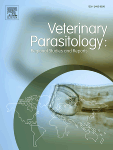Ver ítem
- xmlui.general.dspace_homeCentros e Institutos de InvestigaciónCIPAF. Centro de Investigación y Desarrollo Tecnológico para la Agricultura FamiliarIPAF Región PampeanaArtículos científicosxmlui.ArtifactBrowser.ItemViewer.trail
- Inicio
- Centros e Institutos de Investigación
- CIPAF. Centro de Investigación y Desarrollo Tecnológico para la Agricultura Familiar
- IPAF Región Pampeana
- Artículos científicos
- Ver ítem
Seroprevalence of Toxoplasma gondii and Neospora caninum in family farming goats from the Luracatao Valley, Salta, Argentina
Resumen
Toxoplasma gondii and Neospora caninum infections are important causes of abortion in ruminants. The objective of this study was to determine the seroprevalence and frequency of T. gondii and N. caninum titers in goats raised by family farmers in the Luracatao Valley of Salta province, Argentina. A total of 259 serum samples were collected from adult goats in 42 family farms in nine communities and tested for indirect fluorescent antibody test (IFAT,
[ver mas...]
Toxoplasma gondii and Neospora caninum infections are important causes of abortion in ruminants. The objective of this study was to determine the seroprevalence and frequency of T. gondii and N. caninum titers in goats raised by family farmers in the Luracatao Valley of Salta province, Argentina. A total of 259 serum samples were collected from adult goats in 42 family farms in nine communities and tested for indirect fluorescent antibody test (IFAT, cut-off 1:100). Seroprevalences were 34.36% (89/259) for T. gondii and 64.09% (166/259) for N. caninum. Co-infection was found in 25.86% (67/259) of the goats tested. The most frequent IFAT titer of T. gondii found was 100 (23.93%; 62/259), and only 2% (5/259) of the goats presented titer 800. For N. caninum, the most frequent titers were 100 (25.86%; 67/259), and titers 200 (20.46%; 53/259) and 400 (14.61%, 38/259). The titers found for T. gondii could suggest a chronic infection in goats, being of importance for the region due to meat consumption and cheese production. The elevated seroprevalence of N. caninum identified in this study may be attributed to the community-specific dog population and the close interaction between dogs and goats, despite the absence of a statistically significant association. Subsequent research is warranted to assess the productive implications of T. gondii and N. caninum.
[Cerrar]

Autor
Basset, Carina;
Gos, María Laura;
Steffen, Kevin D.;
Helman, Elisa;
Fitte, Bruno;
Olaizola, Paula Lucia;
Unzaga, Juan Manuel;
Fuente
Veterinary Parasitology: Regional Studies and Reports 49 : 100992. (April 2024)
Fecha
2024-04
Editorial
Elsevier
ISSN
2405-9390
Formato
pdf
Tipo de documento
artículo
Palabras Claves
Derechos de acceso
Restringido
 Excepto donde se diga explicitamente, este item se publica bajo la siguiente descripción: Creative Commons Attribution-NonCommercial-ShareAlike 2.5 Unported (CC BY-NC-SA 2.5)
Excepto donde se diga explicitamente, este item se publica bajo la siguiente descripción: Creative Commons Attribution-NonCommercial-ShareAlike 2.5 Unported (CC BY-NC-SA 2.5)


